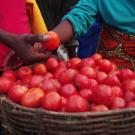There are an estimated one million rural households in Rwanda that grow horticultural commodities. For most households, homegrown fruits and vegetables provide an important source of nutrients as well as income. The poor handling, lack of proper storage and processing practices not only result in a great loss in the market value of the harvested produce but also unavailability during the off-season.
Postharvest solutions that increase the quality and life of horticulture produce through handling, storage, packaging, and better processing can increase their availability and greatly enhance farmers’ income. The Horticulture Innovation Lab project "Reducing Postharvest Losses in Rwanda" in partnership with University of Rwanda, Rwanda Agriculture Board and National Agriculture Development Export Board is working to address issues in the country’s horticulture value chain.
Implemented by Agribusiness Associates Inc., the project's goal is to increase food security in Rwanda by understanding and identifying the most efficient ways to reduce postharvest losses. In April 2018, researchers organized a training on small scale postharvest handling practices with a focus on different drying techniques.
“I was motivated by the training on drying technology and started drying Orange Fleshed Sweet Potatoes (OFSP) for milling and selling the flour,” stated Fortunee Musanabera, a female entrepreneur and one of several hundred of farmers benefiting from the project.
The project has trained and supported a female entrepreneur’s group, INKINGI Y’URUGO in the installation and use of chimney solar dryer and Musanabera is an active member of this group. The solar dryer is accessible to all the members of the group.
Earlier, Musanabera was drying OFSP openly under the sun which was lot of work and had many challenges. She had to remove drying produce quickly if it started raining and it was challenging to even dry produce during rainy months. The birds and other flying insects were another major concern during open-air drying process. Lastly, the hygiene was also not good because she had to touch the drying produce many times.
After the training, Musanabera has started to dry many commodities such as beetroots, amaranths, and igisura (Ilitica dioica) in the chimney solar dryer. Musanabera shared that it takes less time for the commodities to dry with chimney solar dryer than drying under the sun. Additional benefits are, the improved color and quality of the dried produce and its improved safety. Currently, she is selling OFSP flour at 1,000 Rwandan Francs per kilogram, beetroot flour at 4,000 Rwandan Francs per kilogram, igisura at 10,000 Rwanda Francs per kilogram and amaranth flour at 2,000 Rwanda Francs per kilogram.
“Since we started using the chimney solar dryer, I am saving time, safety is acceptable and the market demand of the dried product is high which means my income has also increased,” said Musanabera.
This story was shared during the Rwanda Postharvest Conference in Kigali, Rwanda on June 6, 2019.

